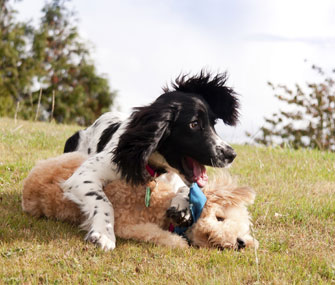Do Senior Dogs Lose Their Alpha Dog Status?
Published on January 28, 2015

Age changes many aspects of a dog’s life, including his relationships with other dogs. As your dog gets older, a change in his canine interactions is normal. For example, an older dog may give up or curtail alpha dog behavior. Instead, it is common for dogs to become more selective about play partners and to engage less in high-impact, fast-paced play as they age.
If you notice any changes in your dog’s behavior, your first stop should be your veterinarian’s office. Dogs are typically able to negotiate relationships with other dogs without intervention, but if fights or injuries are occurring, or negative interactions are becoming more frequent, it’s important to seek professional help immediately. My father, veterinarian Dr. Marty Becker, frequently laments how many issues, such as a hesitation to stand up or lowered desire to play, go ignored in senior dogs because they’re chalked up to old age. Though slowing down can be normal in older dogs, sometimes underlying pain or a medical condition is to blame for a change in a dog’s behavior.
When it comes to understanding what is ideal for a dog’s relationships as he ages, though, it is essential to dispel the myth of the alpha dog. Your older dog does not necessarily feel the need to maintain his alpha position with younger playmates and housemates. In fact, most dogs commonly seen as seeking to be the alpha are actually insecure and are acting out of fear and anxiety rather than a sense of leadership.
The Alpha Dog Ideal
I most often see dominance, or alpha dog, theories used to validate human intervention into canine relationships in ways that escalate conflict. In the case of older dogs, many owners believe that the senior canine always has to have first access to things, like petting, toys or food, in order to keep a younger dog in his place. But in reality, as a dog ages it is common for him to defer and willingly give up first access to food, resting spaces or front position on walks.
A senior dog’s desire for and speed in getting to an item may naturally decrease with age. This change doesn’t necessarily mean the younger dog is suddenly dominant, but rather that priority access to items is fluid and may change depending upon the situation and the desire of the dog for the item.
I find that dog owners are usually more upset about this change than the dogs are, and owners are likely to intervene to obtain the order they desire. However, dominance strategies — like alpha rolls, which are designed to get a dog to submit — can be damaging to your senior dog’s relationship with other canines. Force-based tactics rarely succeed in addressing the root problem; instead, they can exacerbate conflict with other dogs and with people, and they may increase the chances of aggressive behavior.
Instead of relying on dominance and force to maintain your aging dog’s alpha status, let changes happen naturally if they are peaceable. If this approach doesn’t seem to work, or if you have concerns about your dog’s behavior or interaction with other canines, talk to your veterinarian, who may refer you to a trainer specializing in scientifically sound reinforcement methods.
Help Your Dogs Get Along
It’s possible to ease the age transition for your dog with a few simple changes. The first step is to recognize when your older dog may need a break from an overly enthusiastic puppy housemate. A younger dog may not know when to leave an older dog alone and may ignore warnings from his older companion. The older dog may escalate to behavior that causes stress in the home or erupts into physical conflict.
Create separate retreat rooms or spaces in your home where your older dog can have a break from his puppy siblings. You may need to supervise canine interactions to interrupt and redirect your dogs if tension is mounting. When this happens, send both dogs to their retreat spaces for a break. If one dog pesters the other and won’t back down when asked to, attach a dragline to a harness and physically remove the bothersome dog before trouble starts.
It is also important to minimize triggers for fights. This may mean feeding dogs meals and chews in separate areas, for example, if these lead to problems in your dogs’ interaction. Attention can also be a source of conflict: Be sure to provide each dog with individual time for play, training and petting in a way that meets his unique needs. For example, plan some relaxation time on the sofa with your senior dog and playtime at the dog park with your younger dog.
A consistent schedule and clearly stated expectations can also help minimize conflict. A familiar routine that your dogs can count on each day, like a morning walk after breakfast and relaxing playtime after dinner, can promote comfort. In addition, teach your dogs the specific way they need to behave to get a privilege or item they desire, such as asking for a sit before going outside. Being consistent in your expectations and schedule can help alleviate some of the hyperexcitement and competition that otherwise occur when your dogs aren’t sure what’s expected of them.
A dog doesn’t need to be a so-called alpha to be happy in his senior years. Instead, most relational conflict between dogs can be eased by attending to each dog’s unique needs for his particular stage of life.
More From Vetstreet:





